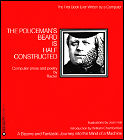 The first edition of the collection of prose, poetry and blank verse titled “The Policeman’s Beard Is Half Constructed“ – supposedly “written” by an artificial intelligence called RACTER – is published by Warner Books. When a commercial version of RACTER is made available, some users cry foul – it doesn’t output anything remotely like the book attributed to it.
The first edition of the collection of prose, poetry and blank verse titled “The Policeman’s Beard Is Half Constructed“ – supposedly “written” by an artificial intelligence called RACTER – is published by Warner Books. When a commercial version of RACTER is made available, some users cry foul – it doesn’t output anything remotely like the book attributed to it. 
Hear about it on the Sci-Fi 5 podcast
 Story: Can computers think? Dream? Display emotion? Racter can. And for the first time, he offers a glimpse into the mind of a computer through a collection of and prose and poetry written without any aid of human interaction or influence. Racter’s thoughts may baffle or confuse you, but they are always sure to make you ponder.
Story: Can computers think? Dream? Display emotion? Racter can. And for the first time, he offers a glimpse into the mind of a computer through a collection of and prose and poetry written without any aid of human interaction or influence. Racter’s thoughts may baffle or confuse you, but they are always sure to make you ponder.
Review: Unfortunately, The Policeman’s Beard Is Half Constructed is one of those times where the story surrounding the end product is more sensational that the end product itself. In 1983, two men named William Chamberlain and Thomas Etter created a computer program that generated prose by using text templates. They called the program “Racter”, which is short for “raconteur”. As a “proof of concept”, they published a book using nothing but the output from the Racter program. Only the introduction, written by Chamberlain, contained human input. That book was “The Policeman’s Beard Is Half Constructed”.
Racter’s saga doesn’t end there, however. Later that year, Mindscape acquired the rights to publish a commerical version of Racter for home computers, such as the IBM PC, Apple II and Amiga (Racter was originally programmed using the CP/M operating system). However, it soon became clear that the home version of Racter was nowhere near as sophisicated as the version of Racter that wrote “The Policeman’s Beard Is Half Constructed”. The home version would take words that the user inputted and tried to use them as frequently as possible in conversation, which did not allow for much variety. Because of this, Mindscape decided to market the program with a humourous bent rather than a serious artifical intelligence, with such claims as “Tongue-In-Chip Software” and “Half-heartedly endorsed by the Institute Of Artifical Insanity”. Many people were disappointed with the program, and some even accused Chamberlain of heavily modifying the original Racter output in “The Policeman’s Beard…” to make it sound more plausible.
How, then, does the book read? As you might imagine, it’s very surreal and hardly follows any conventions of “standard” writing. In one short story, a woman tells her lover that she desires to have a “spooky child”. Her desire, however, is a “furious desire [which] may murder a child. It may be killing babies someday.” Her lover, however, tells her that their children “will whisper of our love”.
There’s also a collection of limericks that seem to display the limitations of Racter quite strongly. The first line almost always begins with an “adjective-adjective-object” and certain words and rhymes are repeated throughout. In another story, Racter talks about a couple who “have love but they also have typewriters. That is interesting.”
The book is illustrated throughout by Joan Hall (who even conducts an “interview” with Racter and herself in the book), using a combination of 1900’s antique portrait drawings and “modern” graph art. Her pictures usually correlate with what Racter is saying (as best as they can, however, given the difficulty noted in what Racter is exactly trying to say).
As a book purely read for recreation, you will no doubt tire of trying to glean anything from Racter’s wisdom and put the book down after only a few pages. But as a small (yet obscure) footnote on computing, “The Policeman’s Beard Is Half Constructed” is a fascinating read on how so much (and yet, so little) has changed in the field. Surrounded now by the most powerful supercomputers the mind can achieve, we tend to forget how simple things were back in the mid-80’s – when a computer was used to just simply talk.
Year: 1984
Author: Racter
Publisher: Warner Books
Pages: 120
Reviewed by: Earl Green